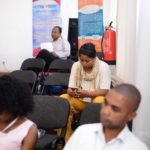
This poignant image shared today by one of my former students, Sevanis Rasolofoniony, captures the aspirations and dreams for a “modern” urban landscape in Madagascar, . It depicts a planned neighborhood in Antananarivo, spanning 67 hectares, which transformed the cityscape from a vernacular hilled capital to a hub of new business, housing, and commercial centers between 1960 and the 1980s, just after the country gained independence. Little did we know that without robust economic support and wise political vision, many of these new facilities would deteriorate due to ongoing intense migration. In the foreground, people are waiting for a taxi-be, a public transport vehicle, which may take hours to reach them home if it even reaches the terminus. Despite promised improvements like cable cars, most public transit stops are left out, leaving residents reliant on the struggling existing system. In the background, notable buildings like Maison des Produits, Ny Havana Insurances HQ, and INSCAE Business School stand as symbols of progress. However, what this image doesn’t show are the struggles beneath the surface — the crowded furniture marketplace recently renovated, or the chaos of Isotry, a once-promising neighborhood, now grappling with urban challenges.
Isotry, stretching from mid-town Isoraka to close to Ikopa river’s dikes Andohotapenaka, is a diverse area, historically populated by migrants. Many families, like my own, have deep roots here, owning properties and businesses starting from the mid-20th century. Isotry’s significance lies in its proximity to the now defuncted river port and colonial built pavilions in Analakely. Yet, over time, flooding and urban issues have plagued this area, leading to displacement and a loss of livelihoods. As I share about my city, I often find myself immersed in nostalgia. However, the neglect experienced by its communities, particularly the vulnerable ones, is impossible to ignore. The middle class struggles, especially during rainy evenings, just to catch a taxi-be. The cityscape continues to change, but not necessarily in ways that mirror our hopes for a “modern” urban landscape in Madagascar. Instead, the new developments prioritize something else — a future marked by emptiness and exclusivity rather than inclusiveness. The imbalances and unfairness in our society are already causing chaos. The right to the city should be a fundamental right accessible to everyone aspiring for a better life; otherwise, we risk drowning in the challenges we face today.


















